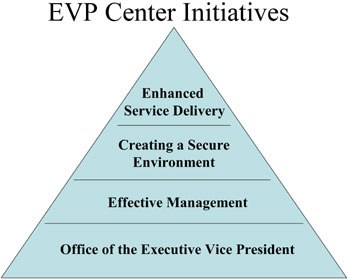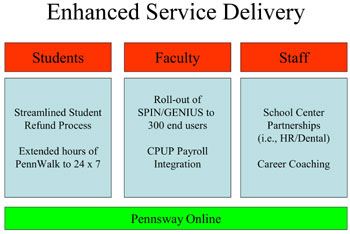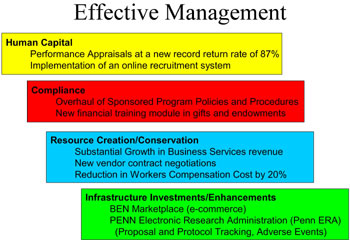
|
COUNCIL The November 3 University Council meeting was primarily devoted to the annual State of the University presentations. President Amy Gutmann's report, including the portions presented by Omar Blaik, Craig Carnaroli and Medha Narvekar appear in this issue. Interim Provost Peter Conn's remarks, along with the portions of his report presented by Carton Rogers and Leslie Hudson will be included in next week's issue. Craig Carnaroli Financial Perspective I intend to provide you a brief overview of the University from a financial perspective as well as a review of some of the accomplishments of the EVP Office in Fiscal 2004. Since I only recently assumed leadership of the EVP office, those accomplishments that you like, I'll be glad to take credit for, those that you have issues with, I'm not responsible for. Dr. Gutmann covered a number of these points, but I will expand on them a little bit from a financial perspective. We did see substantial financial growth in the endowment in this past fiscal year. We had a very strong return, which exceeded our benchmarks by 2 percentage points. We did have some spending decline in Fiscal 2004 as a result of the spending rule formula. However this is poised to recover in Fiscal 2006 and should provide welcome relief to the schools and centers in their operating budgets. We have seen, as a result of the poor economy, increased demand for student aid that we have been able to meet. Direct student aid has increased 8.8 percent. That's direct grants to students—both graduate and undergraduate students—as well as stipends and fellowships in the past year which increased 13 percent. This is before the announcement we made this fall by Dr. Gutmann to increase fellowships in the next fiscal year. Sponsored programs are now the largest single revenue source for the University's research activity. Our research-related revenue this past year grew 4.9 percent. The good news is that new awards actually grew 5 percent; this is very good news because, as you are aware, the NIH is actually leveling off. So the idea that we can attract funds from different sources is a good trend. One of the other good pieces of news is that our employee benefits cost, which has been growing at double digits, actually moderated this past fiscal year. This grew only 6.5 percent over FY03 levels. And that's the good news. We did have some success in our benefit redesign initiatives. We have focused on prescription drug management and moving people to mail order, which is important, as well as greater use of generics. We have a number of wellness initiatives as well, and we're embarking this year on a Condition Management Program for those with chronic illnesses. I've been asked to cover just briefly the activity of the Health System this past year. As Dr. Gutmann commented, this is the fourth consecutive year for positive operations for the Health System. Their patient admissions grew 2.3 percent. We've been very successful in recruiting new physicians to work at our system. In addition, their positive operating performance enabled them to set aside funds for future capital expansion on the Civic Center site. Finally, we completed the sale of Phoenixville Hospital to Community Health Systems, which was a true win-win for the community and Phoenixville, as well as for the Health System. Accomplishments Now let me turn to the EVP Center. Most of you think of the EVP Center as a set of functional units. There's Human Resources, there's Information Systems, and there's Finance. Rather than report on it to you in that manner, instead I took all the accomplishments and said what themes come out of this. Three themes of this area are: enhanced service delivery, creating a secure environment for our faculty, staff and students, and what I call effective management of our resources. Underlying all of this is the Office of the Executive Vice President.
So more specifically on enhanced service delivery, I have some examples I could cite, and I'm only going to pick a few just in the interest of time. One example that I'm particularly proud of in Finance is that we were actually able to streamline the process for student refund checks. In the past, students would show up to get their refund check and be told to come back three days later. That's unacceptable. So we basically were able to streamline this process where it's now sameday turnaround on a single visit. In addition Maureen Rush led an effort to extend the hours of Penn Walk to 24/7.
On the faculty side, one of the things I'm proud of—it only took 25 years—but we were able to integrate the CPUP payroll, which was outside the University's payroll, into the University's payroll system. This is important for a number of tax compliance issues. Then finally on the staff side, we've embarked on some very successful partnerships that enable better resources, for example between HR and Dental as well as some career coaching initiatives. That's still looking at it on a siloed basis. If you try to look at it across the University, we initiated Penn's Way Online. This is important not because Neville and Maureen are the co-chairs this year and have asked me to put in a plug, but more that this actually improves the fundamental process by which we do Penn's Way and it's eliminated the paper process but also allows us to leverage the improved process for other purposes, say if the Vet School wants to do an internal campaign for their project, we can leverage this technology for their needs. A Secure Environment Now in terms of creating a secure environment, generally we think about public safety, but security cuts across a number of different lines so we have been very proactive in our privacy initiatives. I am sure many of you have seen the announcements of schools that have been hacked into and personal information has been taken. We have a very collaborative effort along with the Provost's Office at creating better awareness about where we have risk in releasing student data and SSNs and the like. In addition our IT area has been very successful at reducing our risk with increased virus scanning. Dr. Gutmann commented on our physical safety, there was a reduction of overall crime this past year by 19 percent. One of the big components of the highrise renovation project is the sprinklerization of those buildings, and that is just essential to the safety and well-being of our students.
Effective Management On effective management, I actually think that the people in leadership positions should think of themselves as effective stewards and managers of our resources. So for example, human capital, we spend fifty cents of every dollar at Penn on people and benefits. That requires effective management of those people and I am very pleased to report that on our performance appraisal we had a new record return rate of 87 percent. As we raise the bar in expectations, the need to provide feedback to faculty and staff is incredibly important to enable the institution to maintain the positive momentum going forward.
In the area of compliance, I am pleased to report that we have launched some financial training modules—both through sponsored programs—again that's a third of our revenue base as well as in gifts and endowments. On the resource creation front, we have substantial growth in Business Service revenue this past year, particularly at the Computer Connection, which has very effective leadership. We have also been very successful in renegotiating contracts with different vendors and leveraging the Penn Marketplace through our e-commerce initiatives. And we are also successful in reducing our workers compensation cost by 20 percent. Finally we have been making key investments in IT infrastructure, both in the BEN Marketplace where we do procurement and finally on Electronic Research Administration (Penn ERA) where we launched, the past year, proposal and protocol tracking. Outlook In terms of the outlook—the outlook I would describe, given my financial orientation, I will always be a tad conservative—it is challenging but manageable. Why do I think it's going to be challenging? First, on the extramural research funding we are coming out of a period of explosive growth. If you look back ten years ago to where Penn was, it was around $200 million; we are now close to $700 million. We are just not going to trend at that growth rate over the next decade, so that requires us to identify additional resources. In addition the federal budget deficits that exist are going to pose significant constraints on the federal government's ability to respond to this. In addition we will always have competitive pressures, both in the recruitment and retention of faculty, students, and staff, and we need to be very proactive in that area. Also as we meet next week on the asset allocation for the endowment, almost all the consensus experts think we are going to need a very modest return environment. In other words, in the '90s where we averaged close to 13 percent we are probably in an environment that is more like seven or eight percent. And finally we have some significant plans for the future in terms of campus expansion, and at the same time we have deferred maintenance in the form of facilities' renewal so there will be competing challenges for those resources.
Almanac, Vol. 51, No. 11, November 9, 2004 |
ISSUE HIGHLIGHTS: Tuesday,
November 9, 2004 Volume 51 Number 11 www.upenn.edu/almanac �������������������������������������������������������������������������������������������������������������� |



